Cross-cultural Management and Communication in Woolworths Company in China
VerifiedAdded on 2023/06/12
|14
|3450
|71
AI Summary
This report provides a brief overview of Woolworths Company and identifies key macro and microenvironmental factors and issues that impose an impact on the retail market of China. It also identifies key cross-cultural and HRM issues that may arise between home & host countries and provides recommendations for Woolworths to deal with the identified issues.
Contribute Materials
Your contribution can guide someone’s learning journey. Share your
documents today.
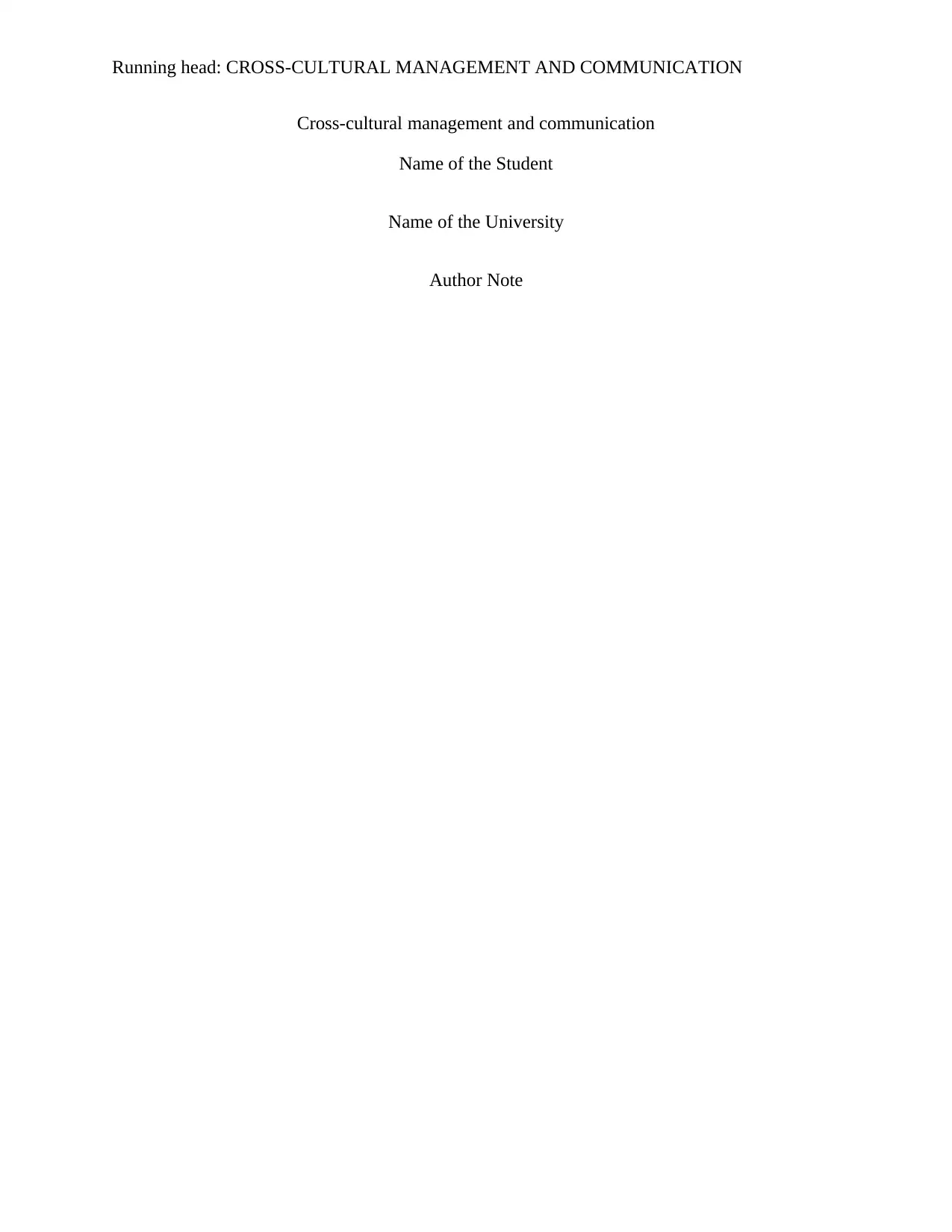
Running head: CROSS-CULTURAL MANAGEMENT AND COMMUNICATION
Cross-cultural management and communication
Name of the Student
Name of the University
Author Note
Cross-cultural management and communication
Name of the Student
Name of the University
Author Note
Secure Best Marks with AI Grader
Need help grading? Try our AI Grader for instant feedback on your assignments.
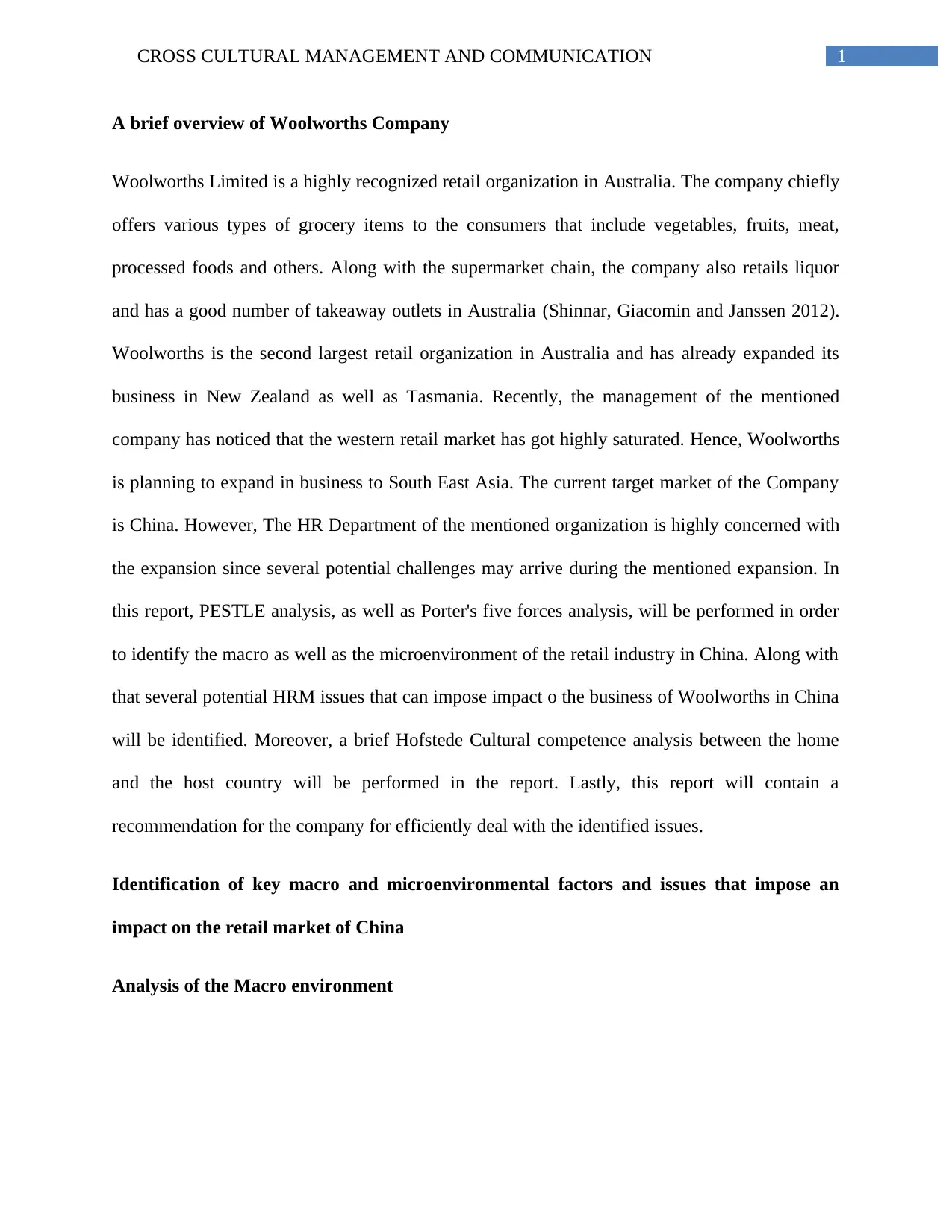
1CROSS CULTURAL MANAGEMENT AND COMMUNICATION
A brief overview of Woolworths Company
Woolworths Limited is a highly recognized retail organization in Australia. The company chiefly
offers various types of grocery items to the consumers that include vegetables, fruits, meat,
processed foods and others. Along with the supermarket chain, the company also retails liquor
and has a good number of takeaway outlets in Australia (Shinnar, Giacomin and Janssen 2012).
Woolworths is the second largest retail organization in Australia and has already expanded its
business in New Zealand as well as Tasmania. Recently, the management of the mentioned
company has noticed that the western retail market has got highly saturated. Hence, Woolworths
is planning to expand in business to South East Asia. The current target market of the Company
is China. However, The HR Department of the mentioned organization is highly concerned with
the expansion since several potential challenges may arrive during the mentioned expansion. In
this report, PESTLE analysis, as well as Porter's five forces analysis, will be performed in order
to identify the macro as well as the microenvironment of the retail industry in China. Along with
that several potential HRM issues that can impose impact o the business of Woolworths in China
will be identified. Moreover, a brief Hofstede Cultural competence analysis between the home
and the host country will be performed in the report. Lastly, this report will contain a
recommendation for the company for efficiently deal with the identified issues.
Identification of key macro and microenvironmental factors and issues that impose an
impact on the retail market of China
Analysis of the Macro environment
A brief overview of Woolworths Company
Woolworths Limited is a highly recognized retail organization in Australia. The company chiefly
offers various types of grocery items to the consumers that include vegetables, fruits, meat,
processed foods and others. Along with the supermarket chain, the company also retails liquor
and has a good number of takeaway outlets in Australia (Shinnar, Giacomin and Janssen 2012).
Woolworths is the second largest retail organization in Australia and has already expanded its
business in New Zealand as well as Tasmania. Recently, the management of the mentioned
company has noticed that the western retail market has got highly saturated. Hence, Woolworths
is planning to expand in business to South East Asia. The current target market of the Company
is China. However, The HR Department of the mentioned organization is highly concerned with
the expansion since several potential challenges may arrive during the mentioned expansion. In
this report, PESTLE analysis, as well as Porter's five forces analysis, will be performed in order
to identify the macro as well as the microenvironment of the retail industry in China. Along with
that several potential HRM issues that can impose impact o the business of Woolworths in China
will be identified. Moreover, a brief Hofstede Cultural competence analysis between the home
and the host country will be performed in the report. Lastly, this report will contain a
recommendation for the company for efficiently deal with the identified issues.
Identification of key macro and microenvironmental factors and issues that impose an
impact on the retail market of China
Analysis of the Macro environment
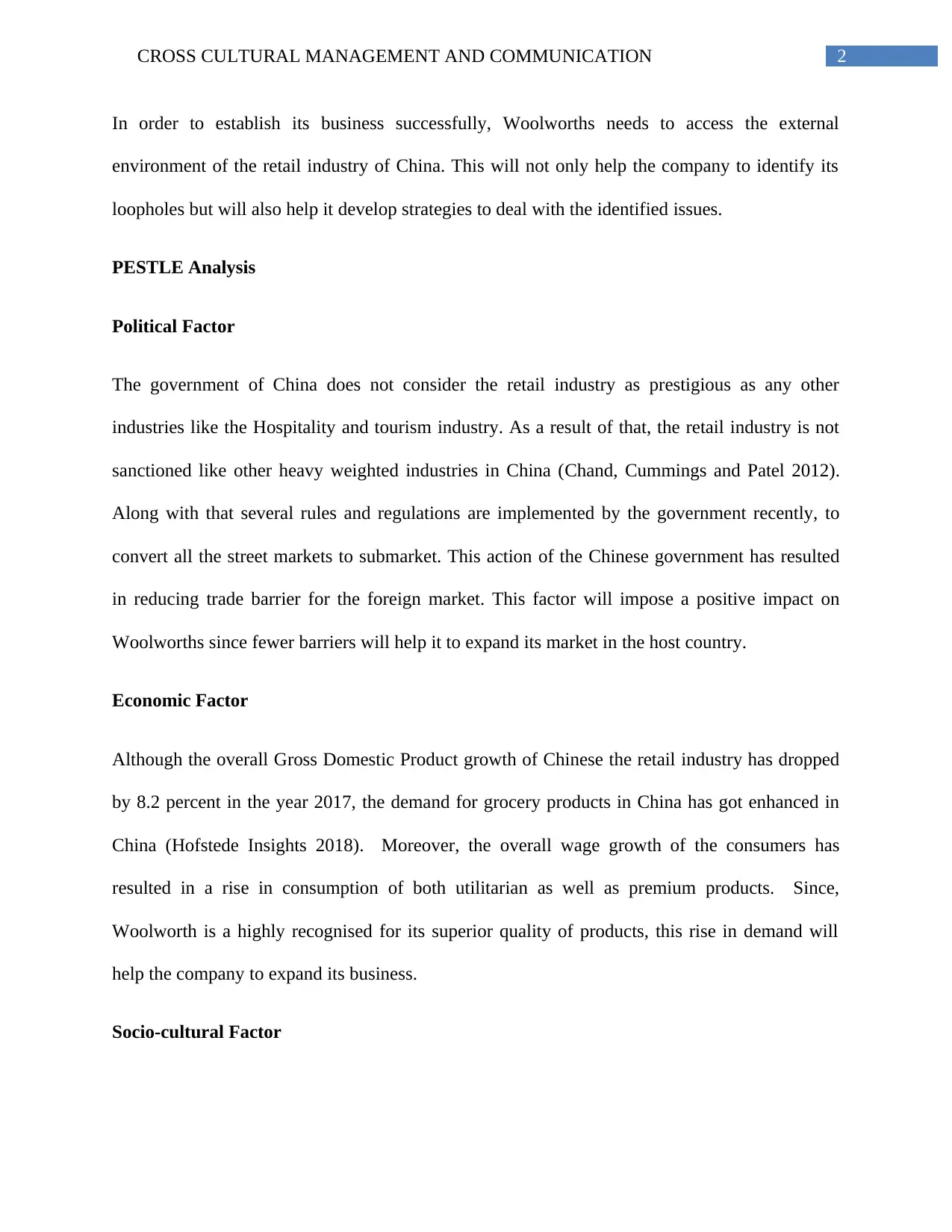
2CROSS CULTURAL MANAGEMENT AND COMMUNICATION
In order to establish its business successfully, Woolworths needs to access the external
environment of the retail industry of China. This will not only help the company to identify its
loopholes but will also help it develop strategies to deal with the identified issues.
PESTLE Analysis
Political Factor
The government of China does not consider the retail industry as prestigious as any other
industries like the Hospitality and tourism industry. As a result of that, the retail industry is not
sanctioned like other heavy weighted industries in China (Chand, Cummings and Patel 2012).
Along with that several rules and regulations are implemented by the government recently, to
convert all the street markets to submarket. This action of the Chinese government has resulted
in reducing trade barrier for the foreign market. This factor will impose a positive impact on
Woolworths since fewer barriers will help it to expand its market in the host country.
Economic Factor
Although the overall Gross Domestic Product growth of Chinese the retail industry has dropped
by 8.2 percent in the year 2017, the demand for grocery products in China has got enhanced in
China (Hofstede Insights 2018). Moreover, the overall wage growth of the consumers has
resulted in a rise in consumption of both utilitarian as well as premium products. Since,
Woolworth is a highly recognised for its superior quality of products, this rise in demand will
help the company to expand its business.
Socio-cultural Factor
In order to establish its business successfully, Woolworths needs to access the external
environment of the retail industry of China. This will not only help the company to identify its
loopholes but will also help it develop strategies to deal with the identified issues.
PESTLE Analysis
Political Factor
The government of China does not consider the retail industry as prestigious as any other
industries like the Hospitality and tourism industry. As a result of that, the retail industry is not
sanctioned like other heavy weighted industries in China (Chand, Cummings and Patel 2012).
Along with that several rules and regulations are implemented by the government recently, to
convert all the street markets to submarket. This action of the Chinese government has resulted
in reducing trade barrier for the foreign market. This factor will impose a positive impact on
Woolworths since fewer barriers will help it to expand its market in the host country.
Economic Factor
Although the overall Gross Domestic Product growth of Chinese the retail industry has dropped
by 8.2 percent in the year 2017, the demand for grocery products in China has got enhanced in
China (Hofstede Insights 2018). Moreover, the overall wage growth of the consumers has
resulted in a rise in consumption of both utilitarian as well as premium products. Since,
Woolworth is a highly recognised for its superior quality of products, this rise in demand will
help the company to expand its business.
Socio-cultural Factor
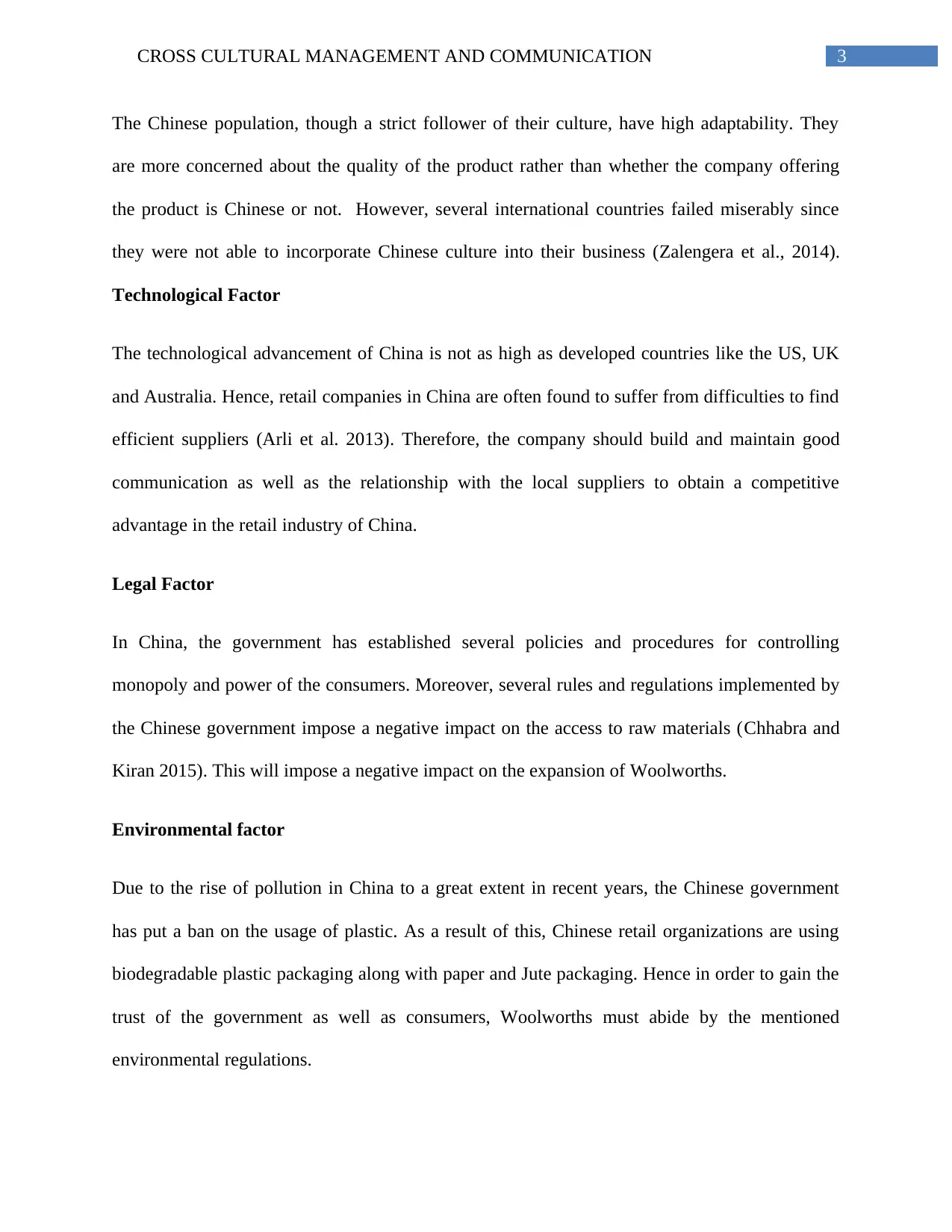
3CROSS CULTURAL MANAGEMENT AND COMMUNICATION
The Chinese population, though a strict follower of their culture, have high adaptability. They
are more concerned about the quality of the product rather than whether the company offering
the product is Chinese or not. However, several international countries failed miserably since
they were not able to incorporate Chinese culture into their business (Zalengera et al., 2014).
Technological Factor
The technological advancement of China is not as high as developed countries like the US, UK
and Australia. Hence, retail companies in China are often found to suffer from difficulties to find
efficient suppliers (Arli et al. 2013). Therefore, the company should build and maintain good
communication as well as the relationship with the local suppliers to obtain a competitive
advantage in the retail industry of China.
Legal Factor
In China, the government has established several policies and procedures for controlling
monopoly and power of the consumers. Moreover, several rules and regulations implemented by
the Chinese government impose a negative impact on the access to raw materials (Chhabra and
Kiran 2015). This will impose a negative impact on the expansion of Woolworths.
Environmental factor
Due to the rise of pollution in China to a great extent in recent years, the Chinese government
has put a ban on the usage of plastic. As a result of this, Chinese retail organizations are using
biodegradable plastic packaging along with paper and Jute packaging. Hence in order to gain the
trust of the government as well as consumers, Woolworths must abide by the mentioned
environmental regulations.
The Chinese population, though a strict follower of their culture, have high adaptability. They
are more concerned about the quality of the product rather than whether the company offering
the product is Chinese or not. However, several international countries failed miserably since
they were not able to incorporate Chinese culture into their business (Zalengera et al., 2014).
Technological Factor
The technological advancement of China is not as high as developed countries like the US, UK
and Australia. Hence, retail companies in China are often found to suffer from difficulties to find
efficient suppliers (Arli et al. 2013). Therefore, the company should build and maintain good
communication as well as the relationship with the local suppliers to obtain a competitive
advantage in the retail industry of China.
Legal Factor
In China, the government has established several policies and procedures for controlling
monopoly and power of the consumers. Moreover, several rules and regulations implemented by
the Chinese government impose a negative impact on the access to raw materials (Chhabra and
Kiran 2015). This will impose a negative impact on the expansion of Woolworths.
Environmental factor
Due to the rise of pollution in China to a great extent in recent years, the Chinese government
has put a ban on the usage of plastic. As a result of this, Chinese retail organizations are using
biodegradable plastic packaging along with paper and Jute packaging. Hence in order to gain the
trust of the government as well as consumers, Woolworths must abide by the mentioned
environmental regulations.
Secure Best Marks with AI Grader
Need help grading? Try our AI Grader for instant feedback on your assignments.
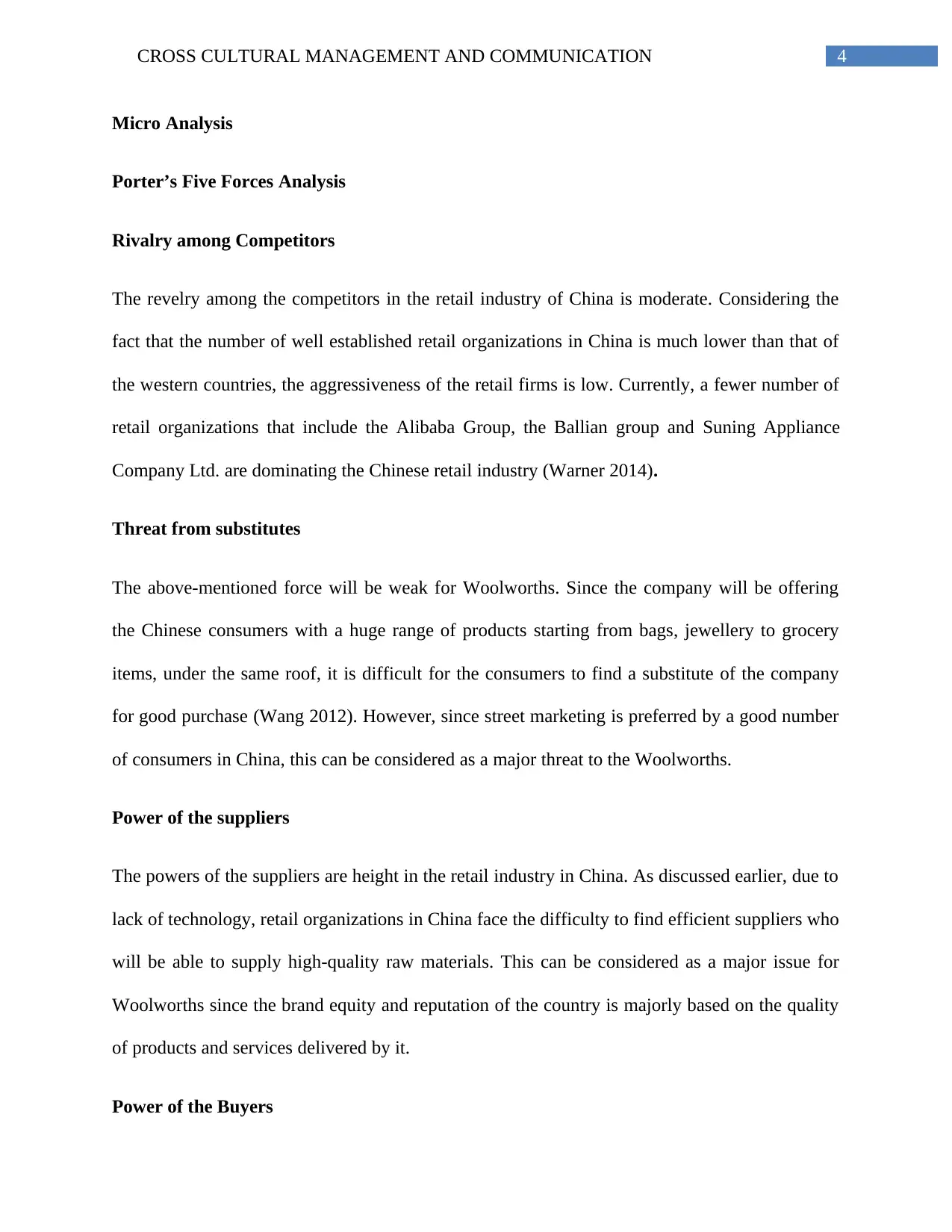
4CROSS CULTURAL MANAGEMENT AND COMMUNICATION
Micro Analysis
Porter’s Five Forces Analysis
Rivalry among Competitors
The revelry among the competitors in the retail industry of China is moderate. Considering the
fact that the number of well established retail organizations in China is much lower than that of
the western countries, the aggressiveness of the retail firms is low. Currently, a fewer number of
retail organizations that include the Alibaba Group, the Ballian group and Suning Appliance
Company Ltd. are dominating the Chinese retail industry (Warner 2014).
Threat from substitutes
The above-mentioned force will be weak for Woolworths. Since the company will be offering
the Chinese consumers with a huge range of products starting from bags, jewellery to grocery
items, under the same roof, it is difficult for the consumers to find a substitute of the company
for good purchase (Wang 2012). However, since street marketing is preferred by a good number
of consumers in China, this can be considered as a major threat to the Woolworths.
Power of the suppliers
The powers of the suppliers are height in the retail industry in China. As discussed earlier, due to
lack of technology, retail organizations in China face the difficulty to find efficient suppliers who
will be able to supply high-quality raw materials. This can be considered as a major issue for
Woolworths since the brand equity and reputation of the country is majorly based on the quality
of products and services delivered by it.
Power of the Buyers
Micro Analysis
Porter’s Five Forces Analysis
Rivalry among Competitors
The revelry among the competitors in the retail industry of China is moderate. Considering the
fact that the number of well established retail organizations in China is much lower than that of
the western countries, the aggressiveness of the retail firms is low. Currently, a fewer number of
retail organizations that include the Alibaba Group, the Ballian group and Suning Appliance
Company Ltd. are dominating the Chinese retail industry (Warner 2014).
Threat from substitutes
The above-mentioned force will be weak for Woolworths. Since the company will be offering
the Chinese consumers with a huge range of products starting from bags, jewellery to grocery
items, under the same roof, it is difficult for the consumers to find a substitute of the company
for good purchase (Wang 2012). However, since street marketing is preferred by a good number
of consumers in China, this can be considered as a major threat to the Woolworths.
Power of the suppliers
The powers of the suppliers are height in the retail industry in China. As discussed earlier, due to
lack of technology, retail organizations in China face the difficulty to find efficient suppliers who
will be able to supply high-quality raw materials. This can be considered as a major issue for
Woolworths since the brand equity and reputation of the country is majorly based on the quality
of products and services delivered by it.
Power of the Buyers
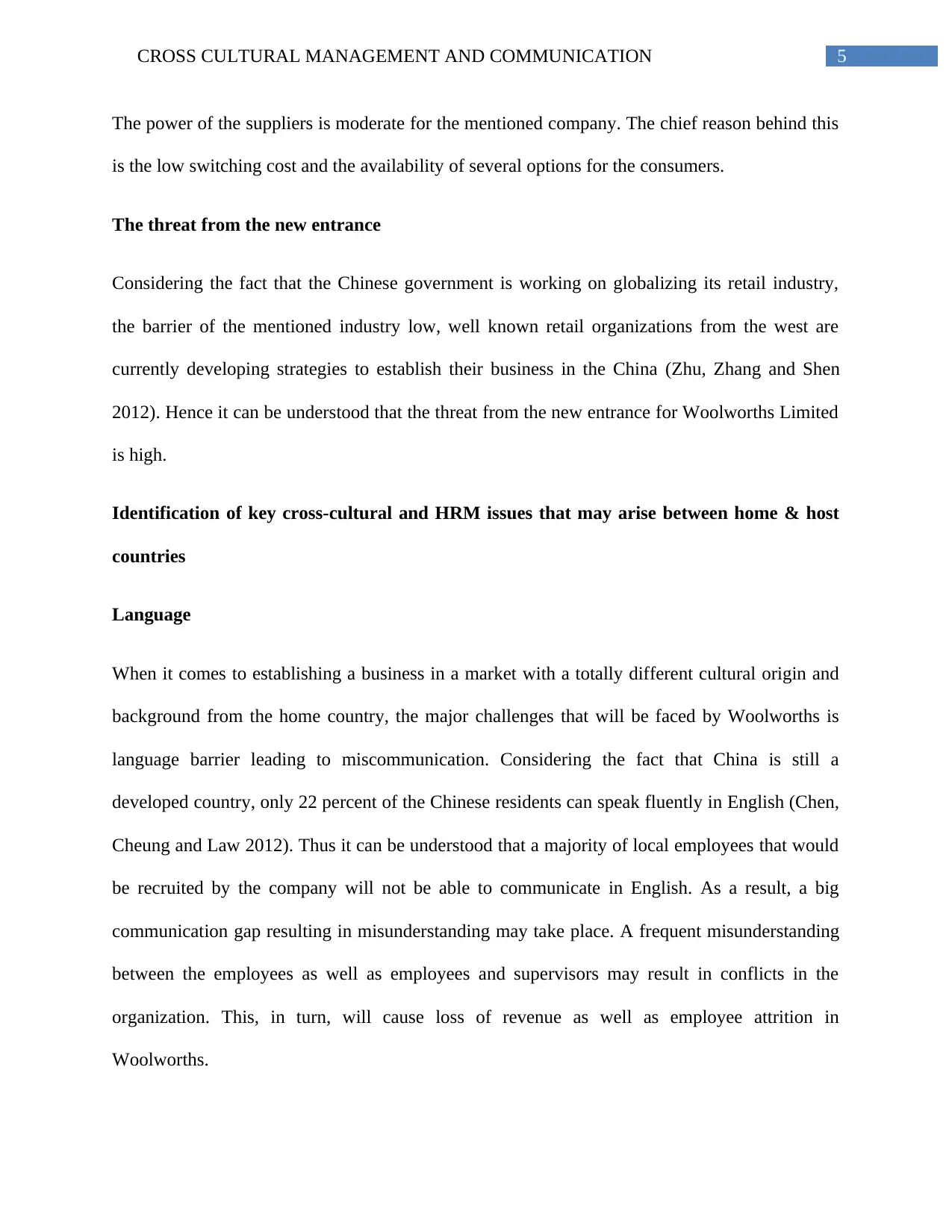
5CROSS CULTURAL MANAGEMENT AND COMMUNICATION
The power of the suppliers is moderate for the mentioned company. The chief reason behind this
is the low switching cost and the availability of several options for the consumers.
The threat from the new entrance
Considering the fact that the Chinese government is working on globalizing its retail industry,
the barrier of the mentioned industry low, well known retail organizations from the west are
currently developing strategies to establish their business in the China (Zhu, Zhang and Shen
2012). Hence it can be understood that the threat from the new entrance for Woolworths Limited
is high.
Identification of key cross-cultural and HRM issues that may arise between home & host
countries
Language
When it comes to establishing a business in a market with a totally different cultural origin and
background from the home country, the major challenges that will be faced by Woolworths is
language barrier leading to miscommunication. Considering the fact that China is still a
developed country, only 22 percent of the Chinese residents can speak fluently in English (Chen,
Cheung and Law 2012). Thus it can be understood that a majority of local employees that would
be recruited by the company will not be able to communicate in English. As a result, a big
communication gap resulting in misunderstanding may take place. A frequent misunderstanding
between the employees as well as employees and supervisors may result in conflicts in the
organization. This, in turn, will cause loss of revenue as well as employee attrition in
Woolworths.
The power of the suppliers is moderate for the mentioned company. The chief reason behind this
is the low switching cost and the availability of several options for the consumers.
The threat from the new entrance
Considering the fact that the Chinese government is working on globalizing its retail industry,
the barrier of the mentioned industry low, well known retail organizations from the west are
currently developing strategies to establish their business in the China (Zhu, Zhang and Shen
2012). Hence it can be understood that the threat from the new entrance for Woolworths Limited
is high.
Identification of key cross-cultural and HRM issues that may arise between home & host
countries
Language
When it comes to establishing a business in a market with a totally different cultural origin and
background from the home country, the major challenges that will be faced by Woolworths is
language barrier leading to miscommunication. Considering the fact that China is still a
developed country, only 22 percent of the Chinese residents can speak fluently in English (Chen,
Cheung and Law 2012). Thus it can be understood that a majority of local employees that would
be recruited by the company will not be able to communicate in English. As a result, a big
communication gap resulting in misunderstanding may take place. A frequent misunderstanding
between the employees as well as employees and supervisors may result in conflicts in the
organization. This, in turn, will cause loss of revenue as well as employee attrition in
Woolworths.
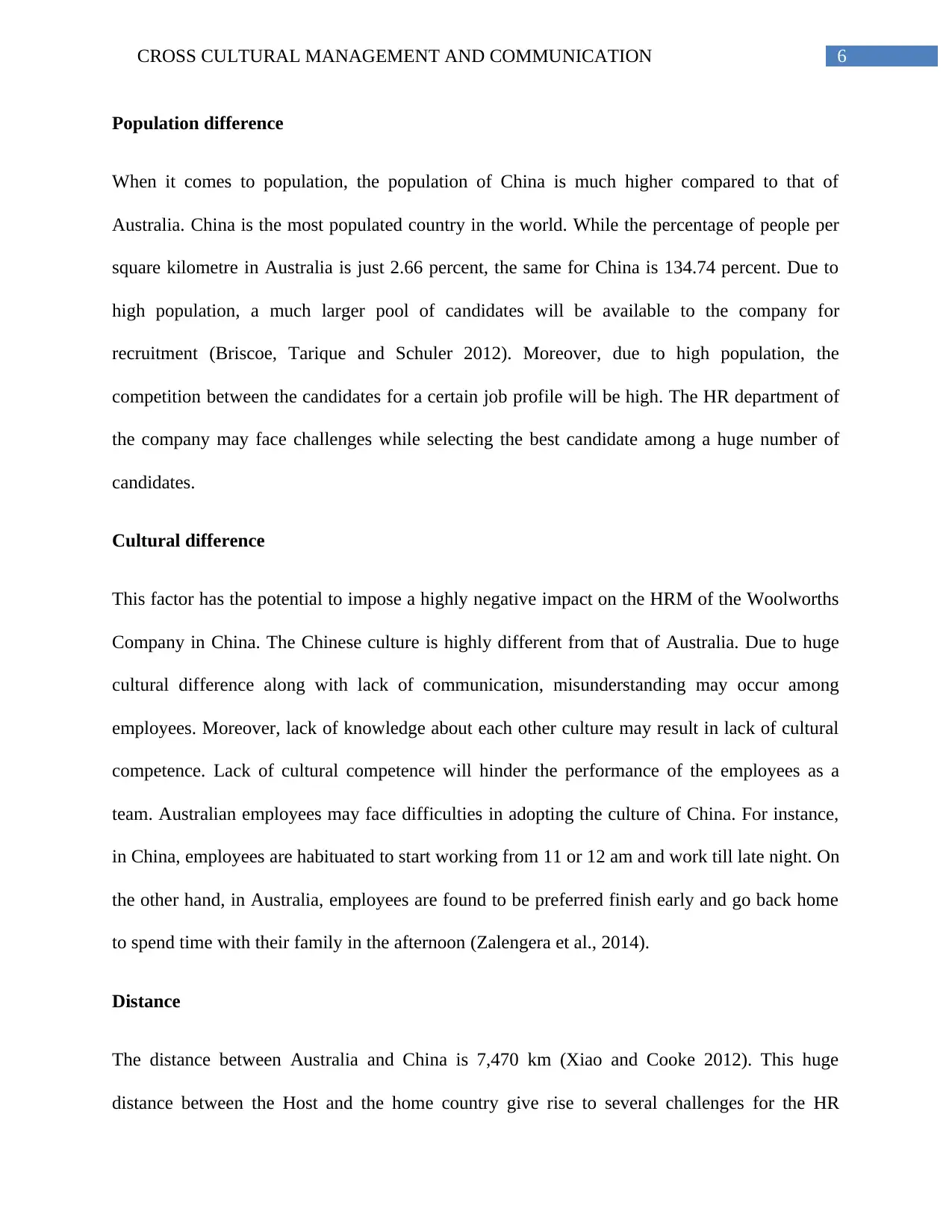
6CROSS CULTURAL MANAGEMENT AND COMMUNICATION
Population difference
When it comes to population, the population of China is much higher compared to that of
Australia. China is the most populated country in the world. While the percentage of people per
square kilometre in Australia is just 2.66 percent, the same for China is 134.74 percent. Due to
high population, a much larger pool of candidates will be available to the company for
recruitment (Briscoe, Tarique and Schuler 2012). Moreover, due to high population, the
competition between the candidates for a certain job profile will be high. The HR department of
the company may face challenges while selecting the best candidate among a huge number of
candidates.
Cultural difference
This factor has the potential to impose a highly negative impact on the HRM of the Woolworths
Company in China. The Chinese culture is highly different from that of Australia. Due to huge
cultural difference along with lack of communication, misunderstanding may occur among
employees. Moreover, lack of knowledge about each other culture may result in lack of cultural
competence. Lack of cultural competence will hinder the performance of the employees as a
team. Australian employees may face difficulties in adopting the culture of China. For instance,
in China, employees are habituated to start working from 11 or 12 am and work till late night. On
the other hand, in Australia, employees are found to be preferred finish early and go back home
to spend time with their family in the afternoon (Zalengera et al., 2014).
Distance
The distance between Australia and China is 7,470 km (Xiao and Cooke 2012). This huge
distance between the Host and the home country give rise to several challenges for the HR
Population difference
When it comes to population, the population of China is much higher compared to that of
Australia. China is the most populated country in the world. While the percentage of people per
square kilometre in Australia is just 2.66 percent, the same for China is 134.74 percent. Due to
high population, a much larger pool of candidates will be available to the company for
recruitment (Briscoe, Tarique and Schuler 2012). Moreover, due to high population, the
competition between the candidates for a certain job profile will be high. The HR department of
the company may face challenges while selecting the best candidate among a huge number of
candidates.
Cultural difference
This factor has the potential to impose a highly negative impact on the HRM of the Woolworths
Company in China. The Chinese culture is highly different from that of Australia. Due to huge
cultural difference along with lack of communication, misunderstanding may occur among
employees. Moreover, lack of knowledge about each other culture may result in lack of cultural
competence. Lack of cultural competence will hinder the performance of the employees as a
team. Australian employees may face difficulties in adopting the culture of China. For instance,
in China, employees are habituated to start working from 11 or 12 am and work till late night. On
the other hand, in Australia, employees are found to be preferred finish early and go back home
to spend time with their family in the afternoon (Zalengera et al., 2014).
Distance
The distance between Australia and China is 7,470 km (Xiao and Cooke 2012). This huge
distance between the Host and the home country give rise to several challenges for the HR
Paraphrase This Document
Need a fresh take? Get an instant paraphrase of this document with our AI Paraphraser
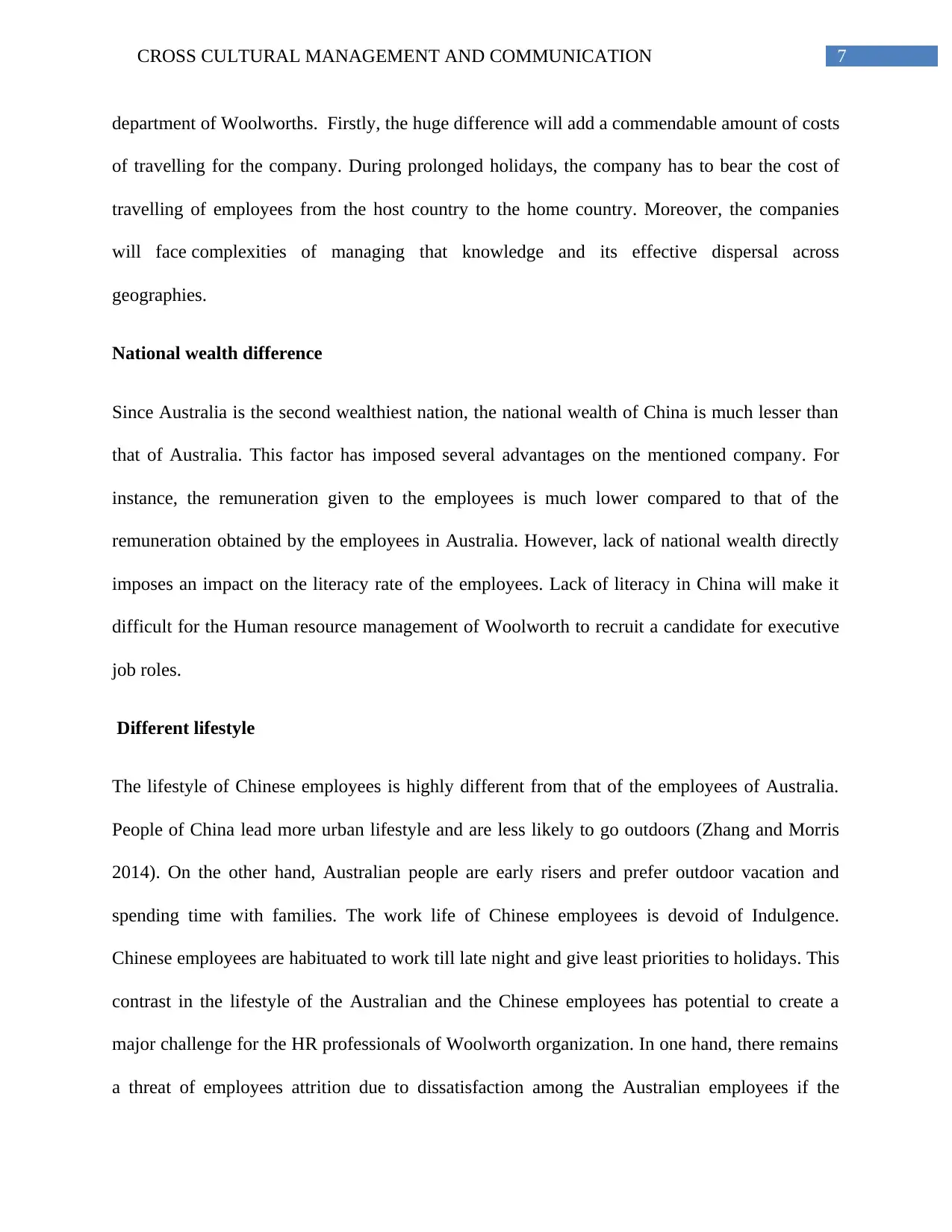
7CROSS CULTURAL MANAGEMENT AND COMMUNICATION
department of Woolworths. Firstly, the huge difference will add a commendable amount of costs
of travelling for the company. During prolonged holidays, the company has to bear the cost of
travelling of employees from the host country to the home country. Moreover, the companies
will face complexities of managing that knowledge and its effective dispersal across
geographies.
National wealth difference
Since Australia is the second wealthiest nation, the national wealth of China is much lesser than
that of Australia. This factor has imposed several advantages on the mentioned company. For
instance, the remuneration given to the employees is much lower compared to that of the
remuneration obtained by the employees in Australia. However, lack of national wealth directly
imposes an impact on the literacy rate of the employees. Lack of literacy in China will make it
difficult for the Human resource management of Woolworth to recruit a candidate for executive
job roles.
Different lifestyle
The lifestyle of Chinese employees is highly different from that of the employees of Australia.
People of China lead more urban lifestyle and are less likely to go outdoors (Zhang and Morris
2014). On the other hand, Australian people are early risers and prefer outdoor vacation and
spending time with families. The work life of Chinese employees is devoid of Indulgence.
Chinese employees are habituated to work till late night and give least priorities to holidays. This
contrast in the lifestyle of the Australian and the Chinese employees has potential to create a
major challenge for the HR professionals of Woolworth organization. In one hand, there remains
a threat of employees attrition due to dissatisfaction among the Australian employees if the
department of Woolworths. Firstly, the huge difference will add a commendable amount of costs
of travelling for the company. During prolonged holidays, the company has to bear the cost of
travelling of employees from the host country to the home country. Moreover, the companies
will face complexities of managing that knowledge and its effective dispersal across
geographies.
National wealth difference
Since Australia is the second wealthiest nation, the national wealth of China is much lesser than
that of Australia. This factor has imposed several advantages on the mentioned company. For
instance, the remuneration given to the employees is much lower compared to that of the
remuneration obtained by the employees in Australia. However, lack of national wealth directly
imposes an impact on the literacy rate of the employees. Lack of literacy in China will make it
difficult for the Human resource management of Woolworth to recruit a candidate for executive
job roles.
Different lifestyle
The lifestyle of Chinese employees is highly different from that of the employees of Australia.
People of China lead more urban lifestyle and are less likely to go outdoors (Zhang and Morris
2014). On the other hand, Australian people are early risers and prefer outdoor vacation and
spending time with families. The work life of Chinese employees is devoid of Indulgence.
Chinese employees are habituated to work till late night and give least priorities to holidays. This
contrast in the lifestyle of the Australian and the Chinese employees has potential to create a
major challenge for the HR professionals of Woolworth organization. In one hand, there remains
a threat of employees attrition due to dissatisfaction among the Australian employees if the
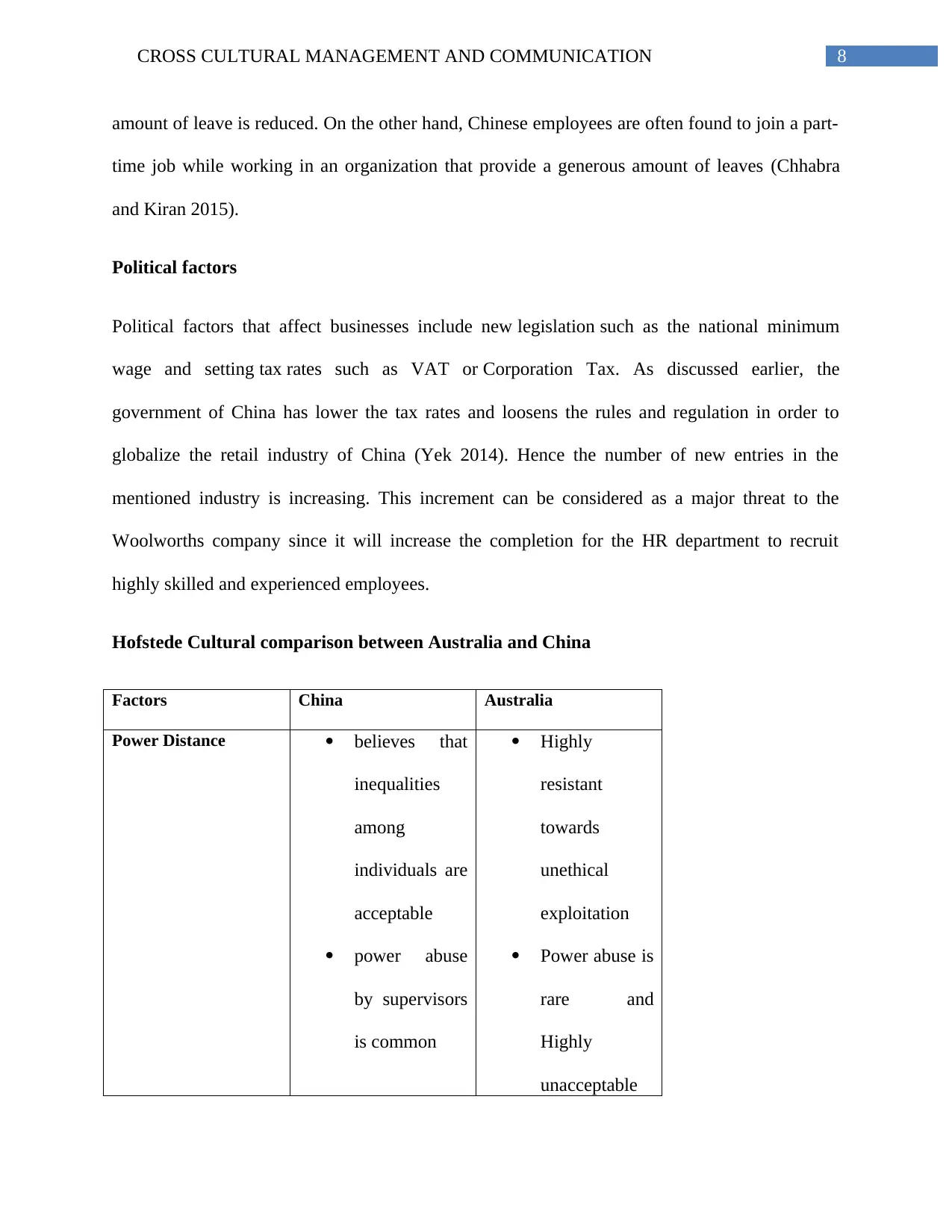
8CROSS CULTURAL MANAGEMENT AND COMMUNICATION
amount of leave is reduced. On the other hand, Chinese employees are often found to join a part-
time job while working in an organization that provide a generous amount of leaves (Chhabra
and Kiran 2015).
Political factors
Political factors that affect businesses include new legislation such as the national minimum
wage and setting tax rates such as VAT or Corporation Tax. As discussed earlier, the
government of China has lower the tax rates and loosens the rules and regulation in order to
globalize the retail industry of China (Yek 2014). Hence the number of new entries in the
mentioned industry is increasing. This increment can be considered as a major threat to the
Woolworths company since it will increase the completion for the HR department to recruit
highly skilled and experienced employees.
Hofstede Cultural comparison between Australia and China
Factors China Australia
Power Distance believes that
inequalities
among
individuals are
acceptable
power abuse
by supervisors
is common
Highly
resistant
towards
unethical
exploitation
Power abuse is
rare and
Highly
unacceptable
amount of leave is reduced. On the other hand, Chinese employees are often found to join a part-
time job while working in an organization that provide a generous amount of leaves (Chhabra
and Kiran 2015).
Political factors
Political factors that affect businesses include new legislation such as the national minimum
wage and setting tax rates such as VAT or Corporation Tax. As discussed earlier, the
government of China has lower the tax rates and loosens the rules and regulation in order to
globalize the retail industry of China (Yek 2014). Hence the number of new entries in the
mentioned industry is increasing. This increment can be considered as a major threat to the
Woolworths company since it will increase the completion for the HR department to recruit
highly skilled and experienced employees.
Hofstede Cultural comparison between Australia and China
Factors China Australia
Power Distance believes that
inequalities
among
individuals are
acceptable
power abuse
by supervisors
is common
Highly
resistant
towards
unethical
exploitation
Power abuse is
rare and
Highly
unacceptable
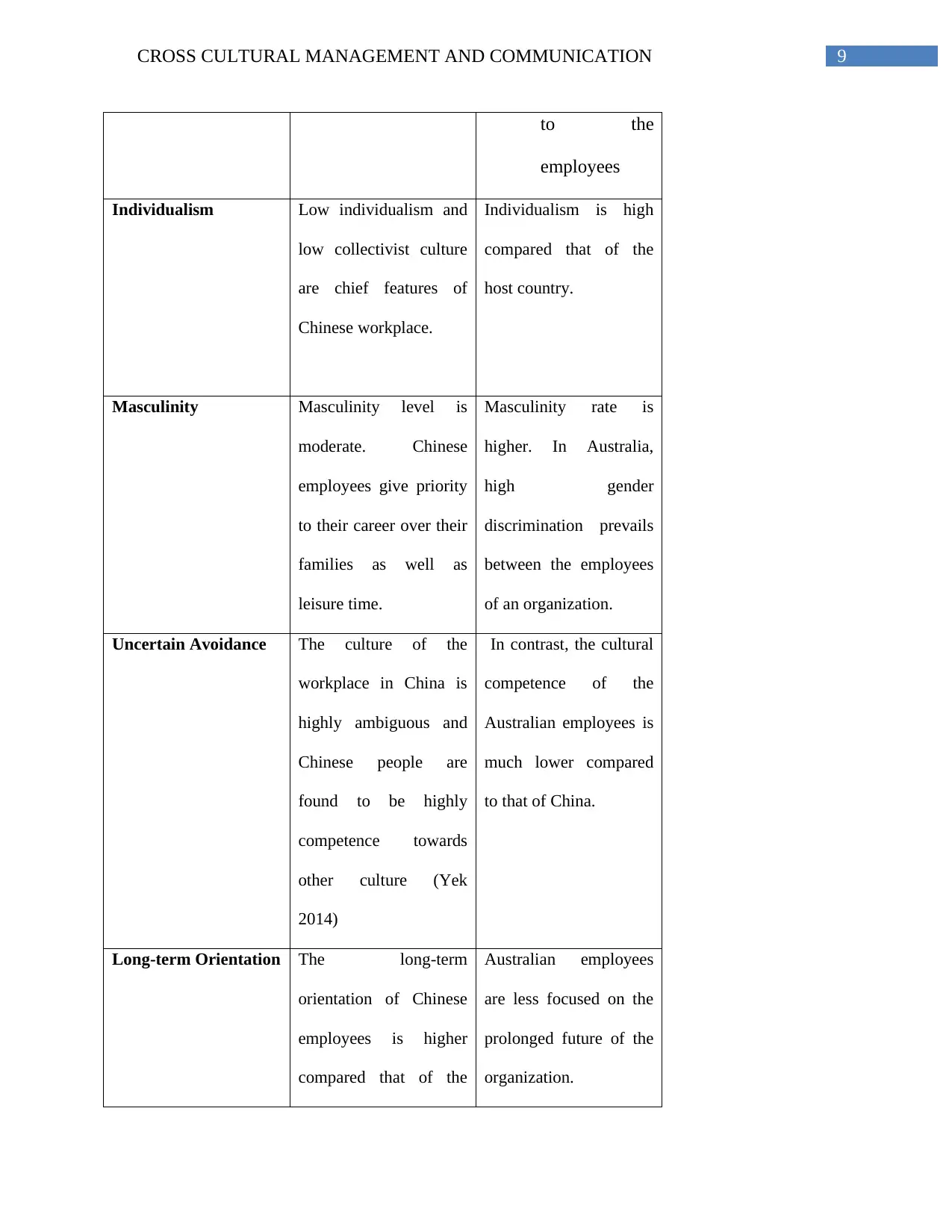
9CROSS CULTURAL MANAGEMENT AND COMMUNICATION
to the
employees
Individualism Low individualism and
low collectivist culture
are chief features of
Chinese workplace.
Individualism is high
compared that of the
host country.
Masculinity Masculinity level is
moderate. Chinese
employees give priority
to their career over their
families as well as
leisure time.
Masculinity rate is
higher. In Australia,
high gender
discrimination prevails
between the employees
of an organization.
Uncertain Avoidance The culture of the
workplace in China is
highly ambiguous and
Chinese people are
found to be highly
competence towards
other culture (Yek
2014)
In contrast, the cultural
competence of the
Australian employees is
much lower compared
to that of China.
Long-term Orientation The long-term
orientation of Chinese
employees is higher
compared that of the
Australian employees
are less focused on the
prolonged future of the
organization.
to the
employees
Individualism Low individualism and
low collectivist culture
are chief features of
Chinese workplace.
Individualism is high
compared that of the
host country.
Masculinity Masculinity level is
moderate. Chinese
employees give priority
to their career over their
families as well as
leisure time.
Masculinity rate is
higher. In Australia,
high gender
discrimination prevails
between the employees
of an organization.
Uncertain Avoidance The culture of the
workplace in China is
highly ambiguous and
Chinese people are
found to be highly
competence towards
other culture (Yek
2014)
In contrast, the cultural
competence of the
Australian employees is
much lower compared
to that of China.
Long-term Orientation The long-term
orientation of Chinese
employees is higher
compared that of the
Australian employees
are less focused on the
prolonged future of the
organization.
Secure Best Marks with AI Grader
Need help grading? Try our AI Grader for instant feedback on your assignments.
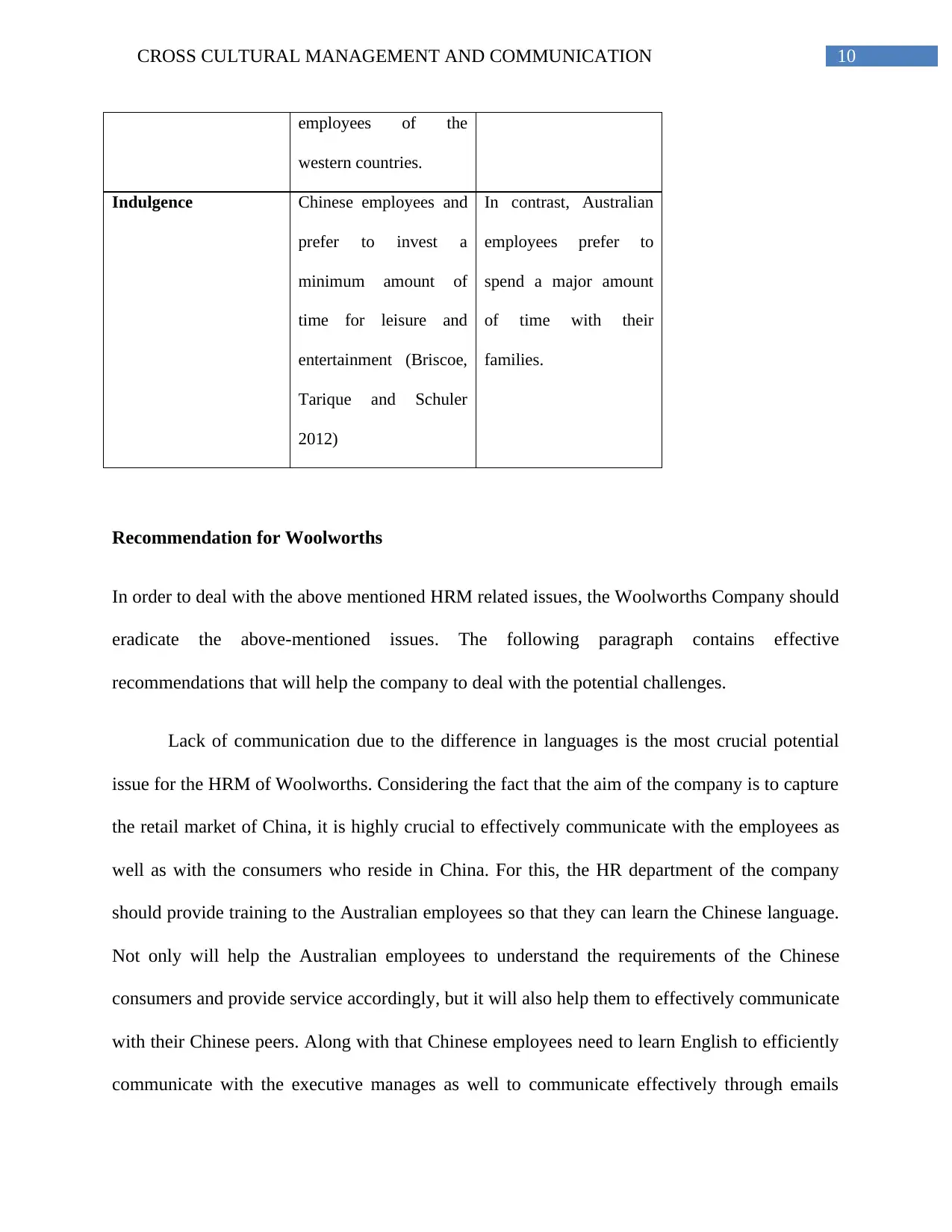
10CROSS CULTURAL MANAGEMENT AND COMMUNICATION
employees of the
western countries.
Indulgence Chinese employees and
prefer to invest a
minimum amount of
time for leisure and
entertainment (Briscoe,
Tarique and Schuler
2012)
In contrast, Australian
employees prefer to
spend a major amount
of time with their
families.
Recommendation for Woolworths
In order to deal with the above mentioned HRM related issues, the Woolworths Company should
eradicate the above-mentioned issues. The following paragraph contains effective
recommendations that will help the company to deal with the potential challenges.
Lack of communication due to the difference in languages is the most crucial potential
issue for the HRM of Woolworths. Considering the fact that the aim of the company is to capture
the retail market of China, it is highly crucial to effectively communicate with the employees as
well as with the consumers who reside in China. For this, the HR department of the company
should provide training to the Australian employees so that they can learn the Chinese language.
Not only will help the Australian employees to understand the requirements of the Chinese
consumers and provide service accordingly, but it will also help them to effectively communicate
with their Chinese peers. Along with that Chinese employees need to learn English to efficiently
communicate with the executive manages as well to communicate effectively through emails
employees of the
western countries.
Indulgence Chinese employees and
prefer to invest a
minimum amount of
time for leisure and
entertainment (Briscoe,
Tarique and Schuler
2012)
In contrast, Australian
employees prefer to
spend a major amount
of time with their
families.
Recommendation for Woolworths
In order to deal with the above mentioned HRM related issues, the Woolworths Company should
eradicate the above-mentioned issues. The following paragraph contains effective
recommendations that will help the company to deal with the potential challenges.
Lack of communication due to the difference in languages is the most crucial potential
issue for the HRM of Woolworths. Considering the fact that the aim of the company is to capture
the retail market of China, it is highly crucial to effectively communicate with the employees as
well as with the consumers who reside in China. For this, the HR department of the company
should provide training to the Australian employees so that they can learn the Chinese language.
Not only will help the Australian employees to understand the requirements of the Chinese
consumers and provide service accordingly, but it will also help them to effectively communicate
with their Chinese peers. Along with that Chinese employees need to learn English to efficiently
communicate with the executive manages as well to communicate effectively through emails
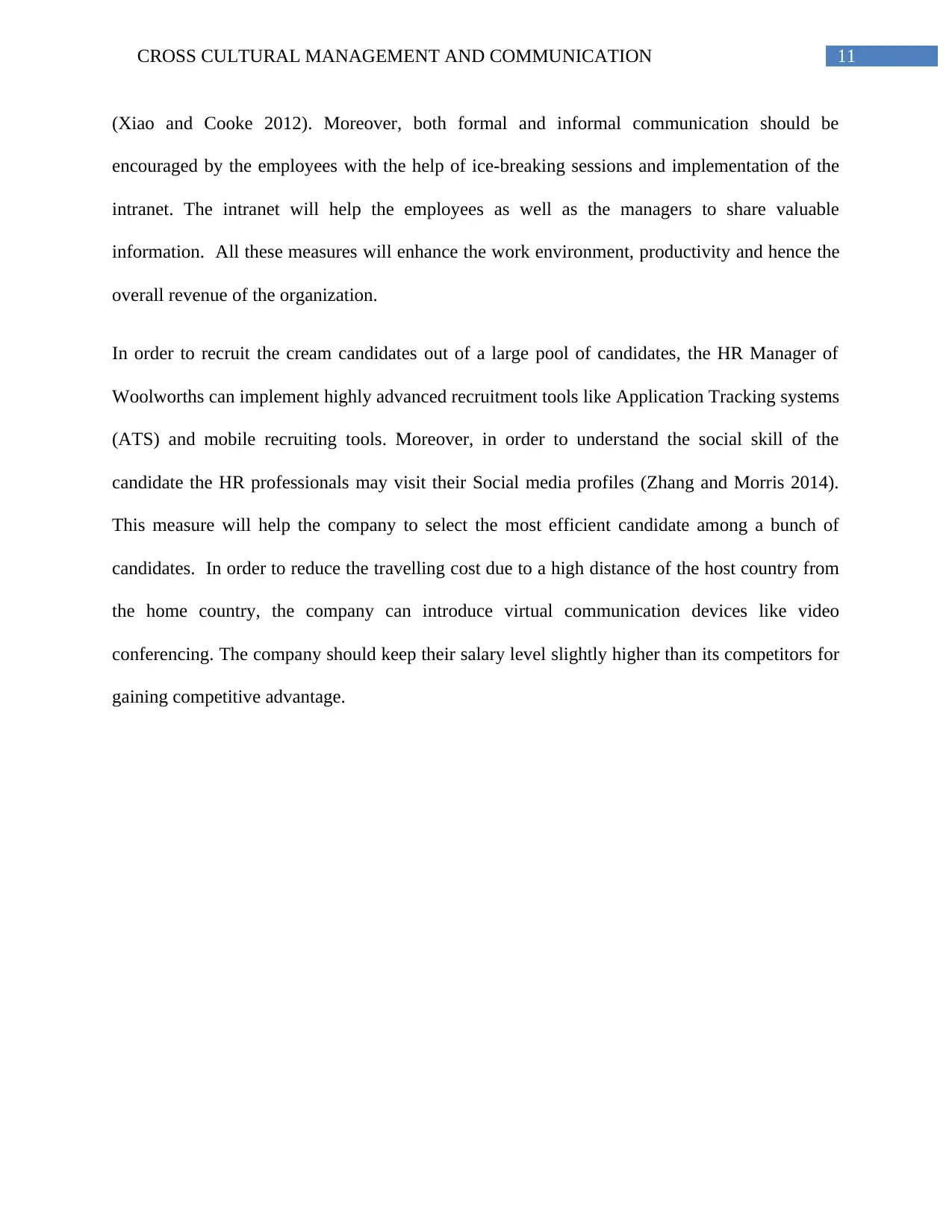
11CROSS CULTURAL MANAGEMENT AND COMMUNICATION
(Xiao and Cooke 2012). Moreover, both formal and informal communication should be
encouraged by the employees with the help of ice-breaking sessions and implementation of the
intranet. The intranet will help the employees as well as the managers to share valuable
information. All these measures will enhance the work environment, productivity and hence the
overall revenue of the organization.
In order to recruit the cream candidates out of a large pool of candidates, the HR Manager of
Woolworths can implement highly advanced recruitment tools like Application Tracking systems
(ATS) and mobile recruiting tools. Moreover, in order to understand the social skill of the
candidate the HR professionals may visit their Social media profiles (Zhang and Morris 2014).
This measure will help the company to select the most efficient candidate among a bunch of
candidates. In order to reduce the travelling cost due to a high distance of the host country from
the home country, the company can introduce virtual communication devices like video
conferencing. The company should keep their salary level slightly higher than its competitors for
gaining competitive advantage.
(Xiao and Cooke 2012). Moreover, both formal and informal communication should be
encouraged by the employees with the help of ice-breaking sessions and implementation of the
intranet. The intranet will help the employees as well as the managers to share valuable
information. All these measures will enhance the work environment, productivity and hence the
overall revenue of the organization.
In order to recruit the cream candidates out of a large pool of candidates, the HR Manager of
Woolworths can implement highly advanced recruitment tools like Application Tracking systems
(ATS) and mobile recruiting tools. Moreover, in order to understand the social skill of the
candidate the HR professionals may visit their Social media profiles (Zhang and Morris 2014).
This measure will help the company to select the most efficient candidate among a bunch of
candidates. In order to reduce the travelling cost due to a high distance of the host country from
the home country, the company can introduce virtual communication devices like video
conferencing. The company should keep their salary level slightly higher than its competitors for
gaining competitive advantage.
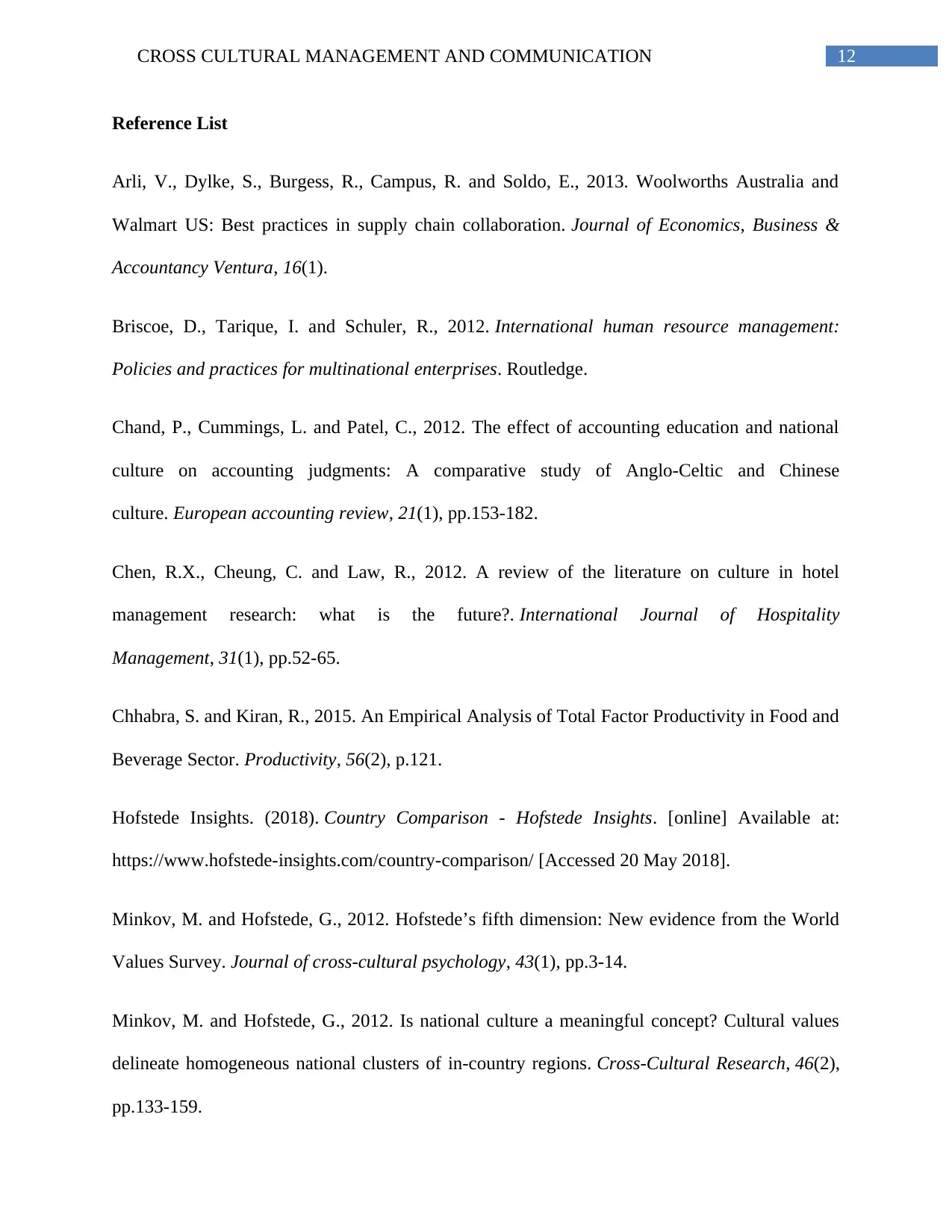
12CROSS CULTURAL MANAGEMENT AND COMMUNICATION
Reference List
Arli, V., Dylke, S., Burgess, R., Campus, R. and Soldo, E., 2013. Woolworths Australia and
Walmart US: Best practices in supply chain collaboration. Journal of Economics, Business &
Accountancy Ventura, 16(1).
Briscoe, D., Tarique, I. and Schuler, R., 2012. International human resource management:
Policies and practices for multinational enterprises. Routledge.
Chand, P., Cummings, L. and Patel, C., 2012. The effect of accounting education and national
culture on accounting judgments: A comparative study of Anglo-Celtic and Chinese
culture. European accounting review, 21(1), pp.153-182.
Chen, R.X., Cheung, C. and Law, R., 2012. A review of the literature on culture in hotel
management research: what is the future?. International Journal of Hospitality
Management, 31(1), pp.52-65.
Chhabra, S. and Kiran, R., 2015. An Empirical Analysis of Total Factor Productivity in Food and
Beverage Sector. Productivity, 56(2), p.121.
Hofstede Insights. (2018). Country Comparison - Hofstede Insights. [online] Available at:
https://www.hofstede-insights.com/country-comparison/ [Accessed 20 May 2018].
Minkov, M. and Hofstede, G., 2012. Hofstede’s fifth dimension: New evidence from the World
Values Survey. Journal of cross-cultural psychology, 43(1), pp.3-14.
Minkov, M. and Hofstede, G., 2012. Is national culture a meaningful concept? Cultural values
delineate homogeneous national clusters of in-country regions. Cross-Cultural Research, 46(2),
pp.133-159.
Reference List
Arli, V., Dylke, S., Burgess, R., Campus, R. and Soldo, E., 2013. Woolworths Australia and
Walmart US: Best practices in supply chain collaboration. Journal of Economics, Business &
Accountancy Ventura, 16(1).
Briscoe, D., Tarique, I. and Schuler, R., 2012. International human resource management:
Policies and practices for multinational enterprises. Routledge.
Chand, P., Cummings, L. and Patel, C., 2012. The effect of accounting education and national
culture on accounting judgments: A comparative study of Anglo-Celtic and Chinese
culture. European accounting review, 21(1), pp.153-182.
Chen, R.X., Cheung, C. and Law, R., 2012. A review of the literature on culture in hotel
management research: what is the future?. International Journal of Hospitality
Management, 31(1), pp.52-65.
Chhabra, S. and Kiran, R., 2015. An Empirical Analysis of Total Factor Productivity in Food and
Beverage Sector. Productivity, 56(2), p.121.
Hofstede Insights. (2018). Country Comparison - Hofstede Insights. [online] Available at:
https://www.hofstede-insights.com/country-comparison/ [Accessed 20 May 2018].
Minkov, M. and Hofstede, G., 2012. Hofstede’s fifth dimension: New evidence from the World
Values Survey. Journal of cross-cultural psychology, 43(1), pp.3-14.
Minkov, M. and Hofstede, G., 2012. Is national culture a meaningful concept? Cultural values
delineate homogeneous national clusters of in-country regions. Cross-Cultural Research, 46(2),
pp.133-159.
Paraphrase This Document
Need a fresh take? Get an instant paraphrase of this document with our AI Paraphraser

13CROSS CULTURAL MANAGEMENT AND COMMUNICATION
Shinnar, R.S., Giacomin, O. and Janssen, F., 2012. Entrepreneurial perceptions and intentions:
The role of gender and culture. Entrepreneurship theory and practice, 36(3), pp.465-493.
Wang, G.G., 2012. Indigenous Chinese HRM research: phenomena, methods, and
challenges. Journal of Chinese Human Resources Management, 3(2), pp.88-99.
Warner, M. ed., 2014. Confucian HRM in greater China: Theory and practice. Routledge.
Xiao, Y. and Cooke, F.L., 2012. Work–life balance in China? Social policy, employer strategy
and individual coping mechanisms. Asia Pacific Journal of Human Resources, 50(1), pp.6-22.
Yek, H.K., 2014. The Effects of Macroenvironment and Sociocultural Factors on the Marketing
Strategy of Retailers-A Case Study on AS Watson Pharmaceutical Stores in Malaysia and
Taiwan.
Zalengera, C., Blanchard, R.E., Eames, P.C., Juma, A.M., Chicago, M.L. and Gondwe, K.T.,
2014. Overview of the Malawi energy situation and A PESTLE analysis for the sustainable
development of renewable energy. Renewable and Sustainable Energy Reviews, 38, pp.335-347.
Zhang, B. and Morris, J.L., 2014. High-performance work systems and organizational
performance: Testing the mediation role of employee outcomes using evidence from PR
China. The International Journal of Human Resource Management, 25(1), pp.68-90.
Zhu, C.J., Zhang, M. and Shen, J., 2012. Paternalistic and transactional HRM: the nature and
transformation of HRM in contemporary China. The International Journal of Human Resource
Management, 23(19), pp.3964-3982.
Shinnar, R.S., Giacomin, O. and Janssen, F., 2012. Entrepreneurial perceptions and intentions:
The role of gender and culture. Entrepreneurship theory and practice, 36(3), pp.465-493.
Wang, G.G., 2012. Indigenous Chinese HRM research: phenomena, methods, and
challenges. Journal of Chinese Human Resources Management, 3(2), pp.88-99.
Warner, M. ed., 2014. Confucian HRM in greater China: Theory and practice. Routledge.
Xiao, Y. and Cooke, F.L., 2012. Work–life balance in China? Social policy, employer strategy
and individual coping mechanisms. Asia Pacific Journal of Human Resources, 50(1), pp.6-22.
Yek, H.K., 2014. The Effects of Macroenvironment and Sociocultural Factors on the Marketing
Strategy of Retailers-A Case Study on AS Watson Pharmaceutical Stores in Malaysia and
Taiwan.
Zalengera, C., Blanchard, R.E., Eames, P.C., Juma, A.M., Chicago, M.L. and Gondwe, K.T.,
2014. Overview of the Malawi energy situation and A PESTLE analysis for the sustainable
development of renewable energy. Renewable and Sustainable Energy Reviews, 38, pp.335-347.
Zhang, B. and Morris, J.L., 2014. High-performance work systems and organizational
performance: Testing the mediation role of employee outcomes using evidence from PR
China. The International Journal of Human Resource Management, 25(1), pp.68-90.
Zhu, C.J., Zhang, M. and Shen, J., 2012. Paternalistic and transactional HRM: the nature and
transformation of HRM in contemporary China. The International Journal of Human Resource
Management, 23(19), pp.3964-3982.
1 out of 14
Related Documents
Your All-in-One AI-Powered Toolkit for Academic Success.
+13062052269
info@desklib.com
Available 24*7 on WhatsApp / Email
![[object Object]](/_next/static/media/star-bottom.7253800d.svg)
Unlock your academic potential
© 2024 | Zucol Services PVT LTD | All rights reserved.





